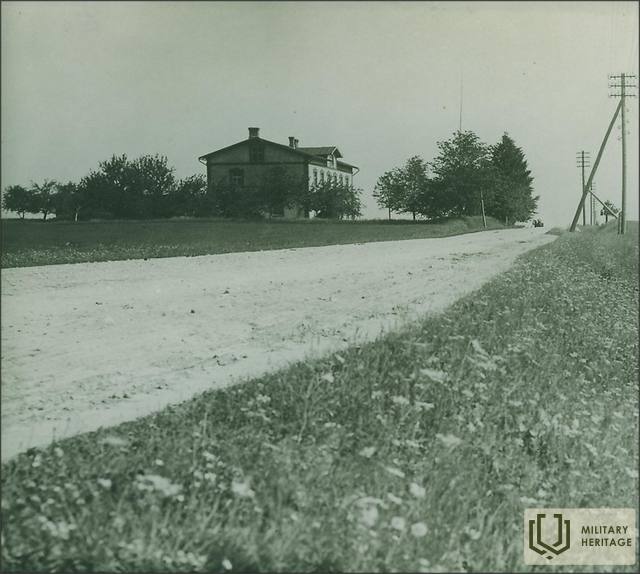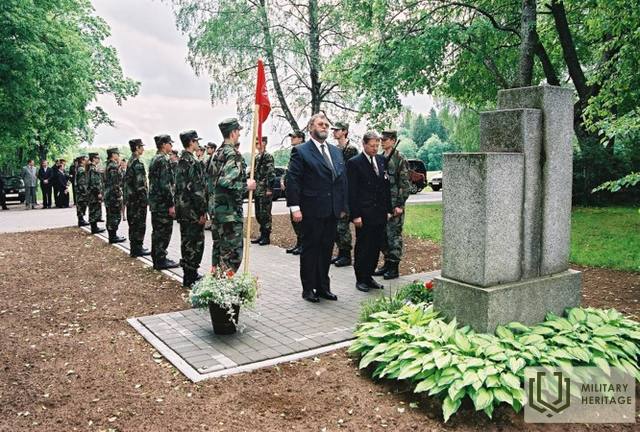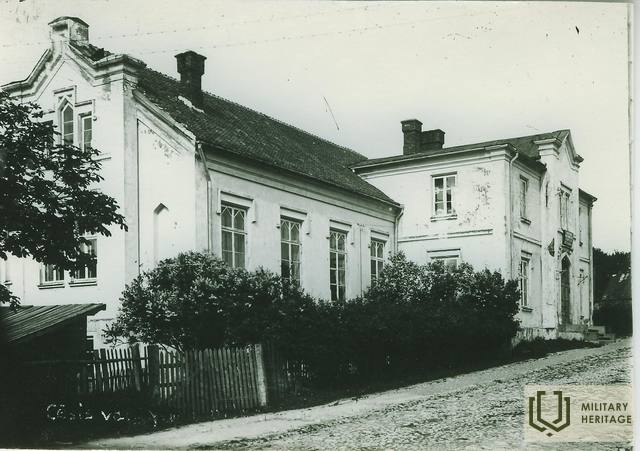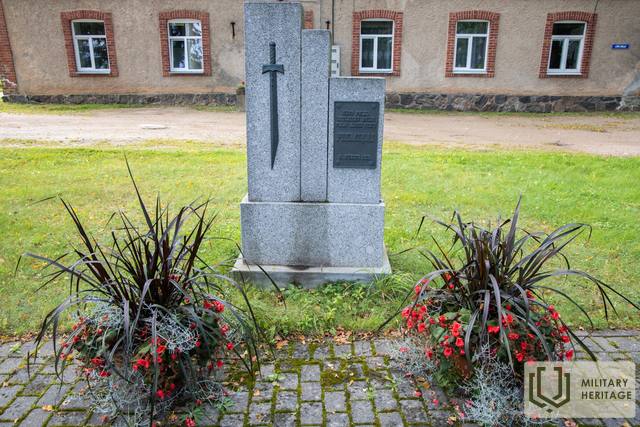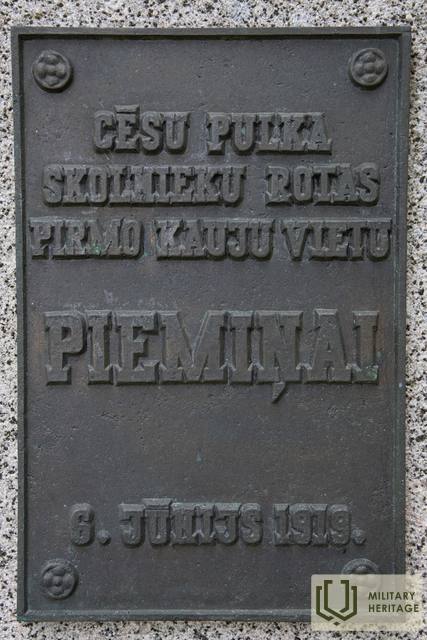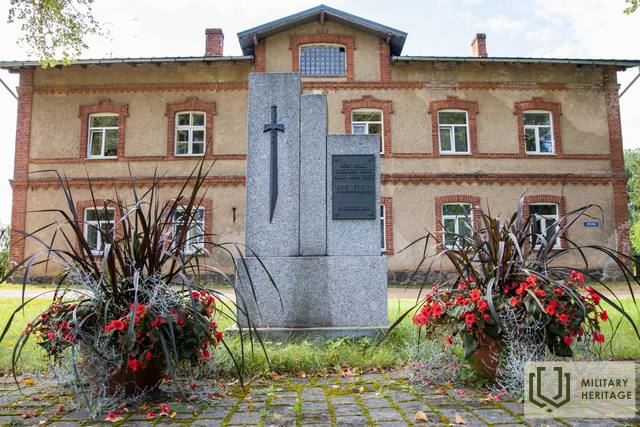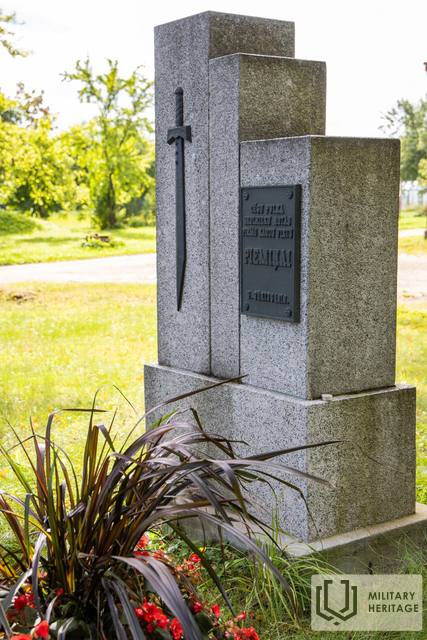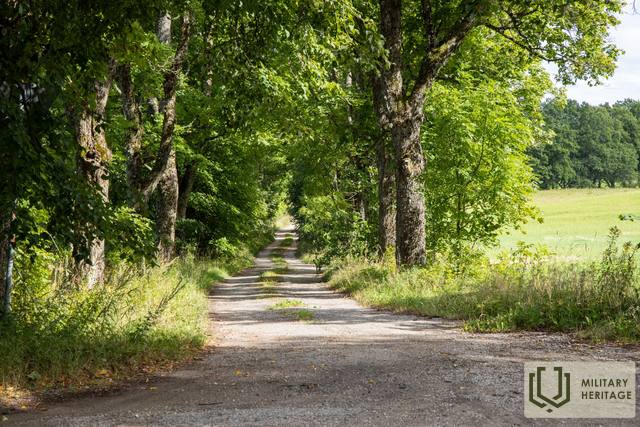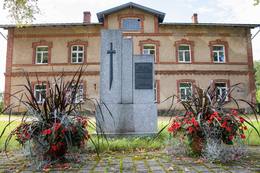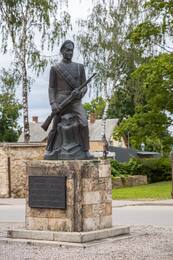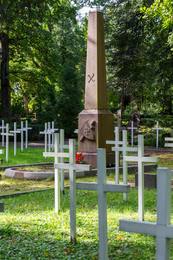Cėsių pulko studentų būriui skirtas paminklas prie buvusių Livu parapijos salės
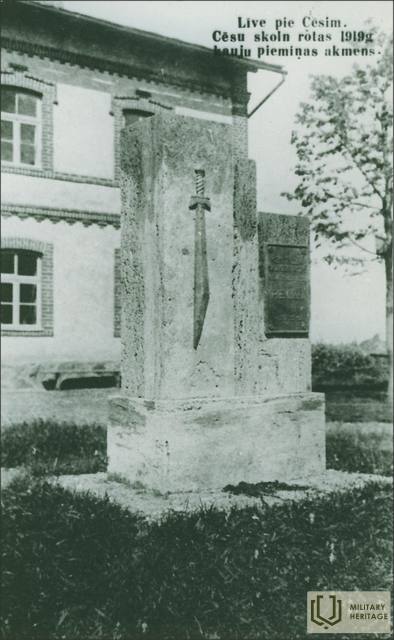
1919 m. Cėsių mūšiuose dalyvavo Cėsių pulko savanorių moksleivių kuopa, kuri birželio 5 d. Cėsių progimnazijos patalpose susiformavo kaip kovinis vienetas iš 108 Valmieros ir Cėsių mokyklų jaunuolių. Jau naktį iš birželio 5 į 6 d., maždaug po valandos vidurnakčio, buvo paskelbtas aliarmas ir kuopai buvo įsakyta persikelti į pozicijas. Kuopa persikėlė į Mācītājmuižos - Meijermuižos liniją, kuri buvo laikoma svarbiausia mūšio vieta.
Pirmajame mūšyje buvo sužeisti keli moksleiviai, tačiau tą pačią dieną nuo labai sunkios pilvo žaizdos mirė Edgaras Krieviņšas, kilęs iš Valmieros. Jis buvo palaidotas su karine pagarba Valmieros miesto kapinėse birželio 13 d. Edgarui Krieviņam po mirties buvo įteiktas Lačplėšio karo ordinas.
1929 m., minint 10-ąsias Cėsių mūšio metines, buvę studentų kuopos kariai įkūrė „Cėsių pulko buvusios savanorių studentų kuopos karių asociaciją“, kuri vėlesniais metais rūpinosi šio karinio dalinio atminimo išsaugojimu ir populiarinimu tarp moksleivių.
Jau 1930 m. Cėsių–Āraišų plento pakraštyje, netoli Lyvų parapijos namų, buvo pastatytas paminklas, žymintis pirmojo kuopos mūšio vietą. Projekto autorius buvo buvęs kuopos kareivis, architektas Kārlis Dzirkalis (1902–1997), o bronzinio reljefo autorius – skulptorius Matīss Pluka (1893–?).
K.Dzirkalis. Ideologinis paminklinio akmens prie Livu parapijos namų paaiškinimas.
„Visų pirma, trys vienas šalia kito sudėti koriai primena kareivių eilę, tai yra eilėje stovinčių kareivių atvaizdus, išdėstytus pagal dydį. Didžiausi tiesioginiai nuopelnai išlaisvinant Latviją taip pat atiteko kareiviams.
Antra, šie akmenys išreiškia mūsų šalies kovos kertinius ir pamatinius akmenis, kuriais tuo metu buvo grindžiama mūsų pergalė. Tai -1.- karių iečių energija ir aštrumas, 2.- įtempta dvasingumo ir entuziazmo dvasia ir 3.- plati meilė tėvynei.
Trečia, paminklinis akmuo žymi mūsų nacionalinės idėjos sukūrimą ir formavimąsi. 1-asis akmuo – ryškios tautinės sąmonės gimimą ir pabudimą, kai latvių mintys ir darbai turėjo būti aštrūs, kad įrodytų savo gyvenimo gebėjimus (Kr. Valdemārs, Rainis ir kt.). 2-asis akmuo savaip žymi tautos susiaurėjimą karo ir pabėgėlių, vargo ir rūpesčių metu. Trečiasis akmuo reiškia dabartinę jaunąją kartą, ant kurios pečių su ginklais rankose jie iškovojo laisvę. Todėl pastaroji yra stabili ir tvirta. Ant jo taip pat bus ženklas lentos pavidalu apie įvykusio didžiojo ir paskutiniojo mūšio pradžią. Kaip žinoma, pirmasis signalas ir šūvis įvyko netoli Livu parapijos namų, kur prasidėjo mūšis tarp moksleivių kuopos ir Manteufelio kavalerijos divizijos.“ (LVVA 1967.fonds, 1. balandžio 1 d., 17-oji byla, 8-asis psl.)
Šaltinis:
Saulė patekėjo nuo kalavijo. Prisiminimų ir dokumentų rinkinys apie Cėsių pulko mokinių kuopą 1919 m. Sudarė Tālis Pumpuriņš. – Cėsys, Cėsių muziejų asociacija, 1994 m.
Apie paminklo griovimą ir restauravimą – J. Lismanio knyga „Mūšių ir žuvusių kareivių atminimui 1915–1920 m.“
Susijusi laiko juosta
Susijusios vietos
Paminklas Moksleivių kuopos mūšio vietoje
Cėsių–Āraišų plento pakraštyje, netoli buvusių Livų parapijos namų.
Galima pamatyti paminklą, skirtą Cėsių pulko savanorių studentų kuopai, dalyvavusiai Cėsių mūšyje 1919 m.
Paminklas buvo atidengtas 1930 m. gegužės 29 d., šalia buvusių Livu parapijos namų.
Paminklo projektą parengė buvęs studentas savanoris K. Dzirkalis, o įrengimo darbus atliko A. Sprogio įmonė Cėsyje.
Bronzines detales pagal autoriaus brėžinį pagamino M. Pluka, o jos buvo nulietos V. Minuto gamykloje Rygoje. Po Antrojo pasaulinio karo paminklas buvo sunaikintas.
Atkurtas 1989 m. birželio 6 d., restauruoto paminklo autoriai buvo skulptoriai A. Jansons ir M. Baltiņa bei architektas I. Timermanis.
Vėliau dėl saugumo priežasčių bronzinis kardas ir plokštelė buvo pašalinti, pakeisti medinėmis dalimis.
Paminklas Cėsių pulko studentams
Paminklas Cėsių pulko studentų kuopos kariams, žuvusiems Cėsių mūšiuose, yra Cėsių mieste, netoli Palasta ir Bērzaines gatvių sankryžos. Paminklo statybą pasiūlė Cėsių pulko studentų kuopos karių asociacija. Paminklas buvo atidengtas 1938 m. gegužės 26 d. Paminklas sukurtas pagal buvusio kuopos kario, dailininko Jānio Rozenbergo, eskizą. Ant metro aukščio kalkakmenio pjedestalo pastatytą 1,8 metro varinę skulptūrą, vaizduojančią karį, vilkintį moksleivio uniformą, sukūrė skulptorius Rūdolfs Āboltiņš ir varkalys Jānis Zibens. Prie kareivio kojų tupi pelėda – išminties ir žinių simbolis, gindama į karą išėjusio studento knygas. Skulptūra buvo nugriauta per pakartotinę sovietų okupaciją 1952 m. 1957 m. netoli buvusios jos vietos buvo pastatytas skulptoriaus Kārlio Jansonso sukurtas paminklas „Komjaunimo vėliavnešys“. Pastatytas netoli istorinės vietos, restauruotas paminklas buvo atidengtas 1992 m. lapkričio 11 d. Tuo pačiu metu, 1992 m., buvo nugriautas okupacinio režimo pastatytas komjaunimo paminklas.
Pirmajame pasauliniame kare žuvusių Latvijos šaulių brolių ir Nepriklausomybės kare žuvusių kareivių kapinės
Įsikūręs Valmieros miesto (centro) kapinėse, Lillijos gatvėje 7.
Galima pamatyti granito obelišką, kurio detales nukalė skulptorius Vilhelmas Trejus.
Paminklas buvo atidengtas 1923 m. birželio 22 d. Brolijos kapinėse palaidota apie 150 kareivių.
Miesto kapinėse palaidoti keli Pirmojo pasaulinio karo ir Nepriklausomybės kovų kovotojai, tarp jų ir pirmasis Cėsių pulko Mokyklos kuopos auka žuvęs LKOK Edgaras Krievinis.
Šiuo metu brolių kapinių dalyje yra 14 įvairaus ilgio kapų grupių, ant kurių sumontuoti 139 balti mediniai kryžiai, tačiau anksčiau ant kryžių buvusių lentelių su žuvusiųjų vardais nebėra. Išliko vienas juodo granito kryžius.
Komunistinės okupacijos metu brolių kapinių dalyje buvo vykdomi intensyvūs civilių laidojimai. Atkūrus nepriklausomybę 1994 m., laidojimo išdėstymas brolių kapinėse buvo pakeistas, dabar kapų grupės išdėstytos kryžmai, tik viena išlaikė buvusią orientaciją.
Atminimo ženklas Cėsių pulko studentų kuopos įkūrimo vietoje
Įsikūręs Leona Paegles gatvėje 1, šalia raudonų plytų pastato fasado.
Memorialo autorė – menininkė Solveiga Vasiljeva, o idėja paremta žiedpumpurio motyvu. Kaip pastebi menininkė, jis simbolizuoja tik pradedančias formuotis asmenybes – studentus, kurie savo dar trumpame gyvenime turi priimti svarbų, atsakingą ir sunkų sprendimą.
Memorialo formoje žiedpumpuro išoriniai žiedlapiai yra geometrinio dizaino, su aštriais kampais, kontrastuojančiais su minkštais, apvaliais žiedlapiais pumpuro viduje. Memorialo aukštis siekia iki 1,5 m. Memorialas buvo atidengtas 2011 m. gegužės 26 d. Valmieroje, toje vietoje, kur 1919 m. buvo suformuota Cėsių pulko kadetų kuopa.
Latvijos kontūrai išdėlioti iš dirbtinių grindinio akmenų, ant kurių paguldyta lentelė su Cėsių pulko Mokinių kuopos vėliava ir tekstu:
„Šioje vietoje 1919 m. gegužės 26 d.
Įkurta „Cėsių pulko mokyklos kuopa“
Cėsių brolių kapinės
Įsikūręs Cėsių Žemutinėse kapinėse, Lenču g. 15, Cėsis.
Viena reikšmingiausių Pirmojo pasaulinio karo ir Nepriklausomybės kovų memorialinių vietų Cėsyje yra Brolių kapinės Lejos Kapuose.
Kapinėse yra Cėsių menininko ir tarybos nario Augusto Jullos (1872–1958) suprojektuotas, 1927 m. atidengtas Brolių kapinių paminklas, skirtas 1915–1920 m. Brolių kapinėse palaidotiems kariams.
Cėsių Lėjos kapinių Brolių kapuose palaidota apie 200 kareivių. Tarp jų yra nežinomas skaičius Latvijos šaulių ir rusų kareivių, žuvusių Pirmajame pasauliniame kare, taip pat vokiečių (10), lenkų ir kitų tautybių kareivių. Latvijos išsivadavimo kovų metu šiose kapinėse palaidoti 22 5-ojo (2-ojo) Cėsių pėstininkų pulko kareiviai, taip pat 11 laisvės kovotojų, žuvusių kituose Latvijos armijos daliniuose. Brolių kapuose taip pat ilsisi 2 estai, 15 bolševikų aukų ir Latvijos raudonieji šauliai.




